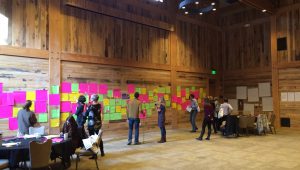Last January, at NAS’ Chief Executive Program convening The New Nature of Relevance, I listened as participants discussed the language we use to communicate about the nonprofit cultural field. Some felt that our current language can intimidate and confuse those who are not familiar with the sector. “Charity” can make us sound needy and helpless, and “nonprofit” makes us sound frivolous and trivial. When I tell people I work in the nonprofit sector, I have often been asked if I earn a salary. These experiences have me thinking about whether we need to consider changing the language commonly used to discuss the sector. How can we help people who aren’t familiar with nonprofit arts fully understand our value?
The conversation about how language shapes perspective is nothing new; the debate about the influence of language has been going on for years. I would argue that the language we use does shape perception and affect comprehension. We live in a culture of classifications. When introduced to something new, we immediately search our mental storage files to find a comparison that will help ease our anxiety or confusion about this new person, place or thing. Our comfort with a topic typically determines whether we engage in conversation about it. “For-profit” is very easy to understand, for example, as most of us have had a lot of experiences and interactions with for-profit businesses. When hearing about a for-profit business, the listener will use their experiences to categorize and organize the new information they are receiving, and will use their perception of the term “for-profit” to help them navigate through the conversation. The presenter uses those assumptions to engage the listener, and help them feel more comfortable in learning about this new venture. “Nonprofit” can be a little harder to immediately understand, and, to boot, the nonprofit arts sector is plagued with various misconceptions and stereotypes. Someone may not understand that we need funding because it sounds like we are not in a business of establishing financial success. Some assume the sector aims only serve wealthy or “educated” people. Others think that because we sell and produce art, an “unnecessary luxury,” we are not viable businesses. As a sector, we need to discover a comprehensible language that breaks down these barriers.
During the Chief Executive Program convening The New Nature of Money, Professor Suzi Sosa taught a session about giving the “perfect pitch.” In order for a pitch to be effective, the presenter must consider their audience, the value and impact created by the organization and why the listener should care about that impact. Ideal pitches are short, compelling stories that draw the audience in, making them want to learn more about the organization, and the language used in this pitch is extremely important. There is no time for field-specific jargon because the listener must be immediately engaged. If the words used in the pitch are not easily comprehensible, we immediately lose the listener, and the chance that we will gain that person’s support decreases.
The current nonprofit terminology guides the way we describe our operational structure and process, as well as our programmatic purpose. Describing our operations more clearly could help in soliciting financial support. Many do not want to contribute towards “overhead” or “general operating support” because they don’t understand how those budgeted costs contribute to the programmatic impact. These terms can be misleading, and affect the potential to increase contributed income. Describing our purpose helps to expand our community, and motivate our champions. Most mission statements, for example, are so weighted and wordy, that it’s hard for a new reader to understand and gain interest. I have had to read some mission statements several times before I understood, or could paraphrase the purpose of the organization. Even if an organization is very valuable, its impact is immediately stifled by the language barrier. If an organization is truly valuable and relevant to its community, they must determine a language that accurately describes that value and impact.
We work in this sector because we truly believe in its effect on civil society. But we can become so emotionally invested in what we do that we sometimes neglect those who are on the outside. We have become accustomed to speaking the language that only those inside the arts sector will understand. Our programs and special events are physically inviting people in, but our language is emotionally and intellectually shutting them out. In order to maximize our value, we need to constantly evaluate our offerings and our language. That way, those who participate can feel more comfortable and confident in learning about what we do, as well as amplifying it. A truly valuable and engaging experience combined with approachable and accurate language will earn us more champions, funding and promotion.

